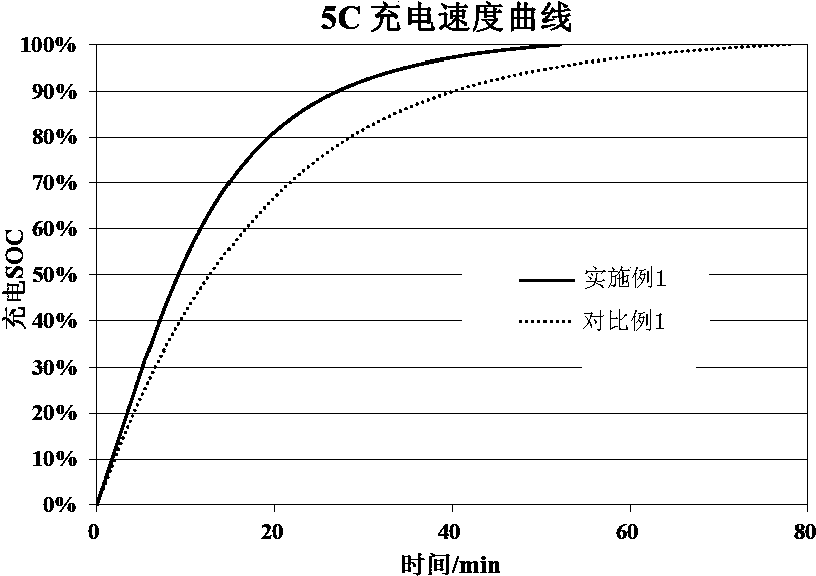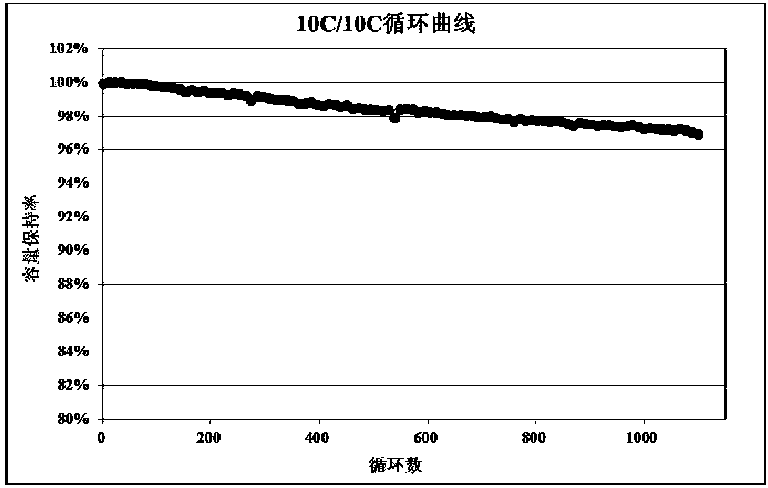Lithium ion battery capable of quick charging
A technology of lithium-ion batteries and separators, applied in battery electrodes, secondary batteries, circuits, etc., can solve the problems of less exposure, and achieve the effects of simplified procedures, excellent rate performance and safety performance, and high-voltage platforms
- Summary
- Abstract
- Description
- Claims
- Application Information
AI Technical Summary
Problems solved by technology
Method used
Image
Examples
Embodiment 1
[0034] A lithium ion battery provided in this embodiment includes a positive electrode sheet, a negative electrode sheet, a separator disposed between the positive electrode sheet and the negative electrode sheet, and an electrolyte;
[0035] The positive electrode sheet includes a positive electrode current collector and a positive electrode active material layer disposed on the surface of the positive electrode current collector. In terms of mass percentage, the positive electrode active material layer includes the following components:
[0036] Positive electrode active material nickel cobalt lithium manganese oxide 80%;
[0037] Positive electrode active material lithium iron phosphate 15%
[0038] Positive electrode conductive agent carbon black 2.5%;
[0039] Positive electrode binder polyvinylidene fluoride 2.5%;
[0040] The positive current collector is an aluminum foil with a thickness of 16 μm.
[0041] The negative electrode sheet includes a negative electrode c...
Embodiment 2
[0060] The difference from Example 1 is that the positive electrode active material is a mixture of lithium nickel cobalt aluminate and lithium iron phosphate, the mass ratio of the two is 70:25, the surface of lithium iron phosphate is covered with a carbon layer, and the mass of the carbon layer is the same as The mass ratio of lithium iron phosphate is 1:100, and the mass content of the positive electrode active material is 95%; the positive electrode conductive agent is a mixture of carbon nanotubes and carbon black, and the mass ratio of the two is 1:1; the positive electrode binder Be sodium alginate; All the other are with embodiment 1, do not repeat them here.
Embodiment 3
[0066] The difference from Example 1 is that the positive electrode active material is a mixture of lithium cobaltate and lithium iron phosphate, the mass ratio of the two is 80:10, and the mass content of the positive electrode active material is 90%, wherein the lithium cobaltate doped There is Mg with a mass percentage of 1%, the surface of lithium iron phosphate is coated with a carbon layer, and the ratio of the mass of the carbon layer to the mass of lithium iron phosphate is 0.5:100; the positive electrode conductive agent is a mixture of carbon nanotubes and graphene, And the mass content of carbon nanotubes is 2%, and the mass content of graphene is 3%; The positive electrode binder is polyvinyl alcohol, and the mass content of positive electrode binder is 5%; All the other are the same as embodiment 1, no longer here repeat.
PUM
| Property | Measurement | Unit |
|---|---|---|
| thickness | aaaaa | aaaaa |
Abstract
Description
Claims
Application Information
 Login to View More
Login to View More - R&D
- Intellectual Property
- Life Sciences
- Materials
- Tech Scout
- Unparalleled Data Quality
- Higher Quality Content
- 60% Fewer Hallucinations
Browse by: Latest US Patents, China's latest patents, Technical Efficacy Thesaurus, Application Domain, Technology Topic, Popular Technical Reports.
© 2025 PatSnap. All rights reserved.Legal|Privacy policy|Modern Slavery Act Transparency Statement|Sitemap|About US| Contact US: help@patsnap.com



